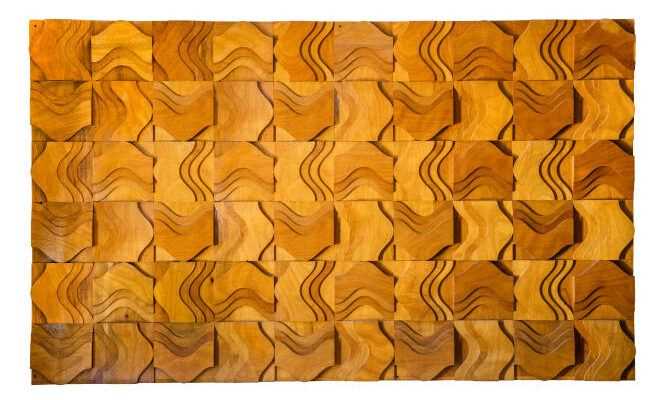To stay up to date on African news, subscribe to the “Monde Afrique” newsletter from this link. Every Saturday at 6 am, find a week of current events and debates treated by the editorial staff of “Monde Afrique”.
Will the painted ceilings of the Moroccan hotel Rose du Dadès be sold cut to size? This is what the Mamma association (Memory of modern Moroccan architects), founded by architects Imad Dahmani and Lahbib El Moumni, fears to watch over the modern architectural heritage of the kingdom. A fear fueled by the public auction organized by Artcurial on May 30 in Marrakech, during which some thirty works and decorative elements risk being dispersed.
Designed by the artists Mohammed Chabâa and Mohamed Melehi, “These works were designed for the hotel and permanently integrated into the architecture”, underlines the association, at the origin of an open letter sent on April 24 to the Ministry of Culture and the National Museum Foundation. “Not keeping these buildings in their entirety amounts to obliterating the memory of modern Moroccan art”, we read in their petition published on the Avaaz website.
Built between 1971 and 1972 in Kelaat M’Gouna, in southern Morocco, by architects Abdeslem Faraoui and Patrice de Mazières, the Rose du Dadès hotel was part of the tourist network developed in rural areas of the Cherifian kingdom in the 1970s It is regarded as one of the examples of the successful marriage between creators and architects, and the testimony of the vernacular roots of the group of artists of Casablanca.
On the site bauhaus.imaginista.org, the researcher Maud Houssais thus recalls that Mohamed Melehi was inspired for the ceiling of a colored wave which dressed the rural mosques of the Souss region, discovered in the 1960s. The local architecture had also influenced the perforated walls ( claustras) by Mohammed Chabâa.
“Their place is in a museum”
His daughter, Nadia, insists: “It is not a question of individual works, but of integrations, which exist only where they have emerged. “ For the heiress of the painter who died in 2013, the sale violates the moral rights of artists and their descendants.
Director of Artcurial Marrakech, Olivier Berman accepts the attacks, but wants to dispassionate the debate. ” I understand the point of view of rights holders, he confides, but this hotel was created fifty years ago and no one has ever cared about it, nor have other hotels that have been emptied or destroyed. It is up to the Ministry of Culture to assume its responsibilities. “
The latter just announced on April 13 on Twitter the launch of a hotel classification procedure, which however would not prohibit the transfer. But, ” the works will be banned from leaving Moroccan territory “, Confirms Olivier Berman who considers” that ideally their place is in a museum “.
Pauline de Mazières, the widow of the architect of the hotel, is also convinced of this. Three weeks ago, she sent a request to the National Museum Foundation for these integrations to be pre-empted by the state and protected in a national museum.
“A marginalized or denatured heritage”
Without news for the moment from the public authorities, the Mamma association plans to file a request for classification of the Roses of Dadès, but also of two other establishments built in the same way by the duo Faraoui-De Mazières: the Ibn Toumart hotel. in Taliouine, long abandoned, as well as the Dades Gorges, already emptied of its decorations. If the Ministry of Culture accedes to their request, it will undoubtedly be a first.
Because, to date, the 1980 law relating to the registration and conservation of historic monuments has almost never been applied to buildings erected after the 1960s. its site, we only note the holiday village of Cabo Negro, built on the coast of Tetouan by the architect Elie Azagury in the years 1974-1985.
” Traditional Moroccan buildings have been protected, observes Imad Dahmani, but the post-independence heritage is marginalized or distorted. This is the case with the Almoravides hotel in Marrakech, dating from 1970-1972, whose interiors were completely dismantled in general indifference. Some buildings were even quite simply destroyed, like the National Tea Office, erected in 1960-1962 by Elie Azagury and Henri Tastemain, then demolished in 2018.
The Mamma association saw as a victory the temporary suspension, in February, of the development works of the administrative court of Agadir, which would have altered this symbol of the reconstruction of the city after the earthquake of 1960. “In 2018, during Heritage Days, we held conferences around this brutalist architecture, to raise awareness, and today it is bearing fruit. », Welcomes Lahbib El Moumni.
But heritage registration is not everything. Listed in 2000, the facade of the former Lincoln hotel erected in 1914 in Casablanca partially collapsed in December 2020, due to lack of maintenance. If the law prohibits the demolition of a building considered historic, it does not force its owner to undertake a restoration.
